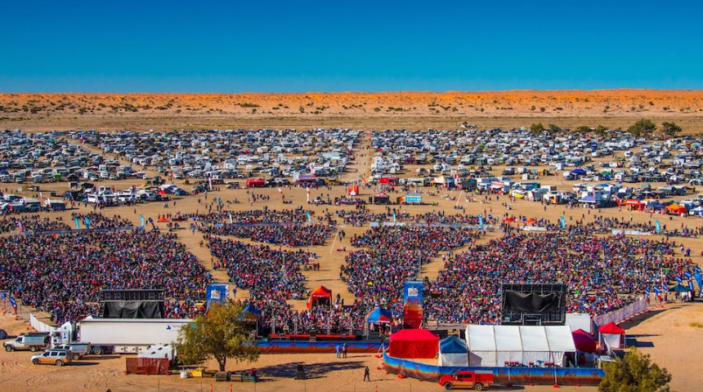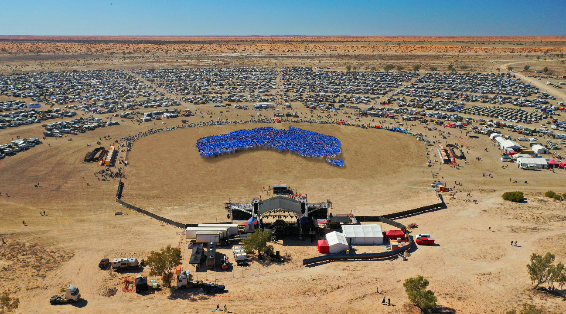
The Big Red Bash and the Mundi Mundi Bash are two quintessentially Australian events held in the Australian outback. We had a chat with the founder of the events, Greg Donovan, about how the events have evolved and what makes them a success.
Let’s start at the beginning, with the Big Red Run. How did that event come about?
It came after some other running events that I’d done around the world. In 2012 we did four desert runs in the one year. We ran the Atacama Desert in Chile, the Gobi Desert in China, the Sahara Desert in Egypt and then Antarctica. We went running all round the world at the different deserts and decided to start up a similar run in Australia to raise funds against Type 1 diabetes.
This was a first for Australia, so we set up the Big Red Run in 2013. We opened it up to participants with the requirement that they do some fundraising. That first year we decided to set up in the Simpson Desert near Birdsville, probably the closest town. To celebrate and to thank the volunteers, we managed to get John Williamson to agree to come out and play on the dune. Which is how the music side of things came about. A few people heard that he was playing, so we sold a few tickets to help cover some of the costs. That’s how it started. Between runners, volunteers, and ticket buyers we had about 500 people on the Big Red Dune watching John Williamson.
It’s come full circle with John Williamson playing the two events this year, with the latest fundraising idea, The Big Blue Day.
As part of the tenth anniversary, we came up an idea for fundraising for Juvenile Diabetes. We’re having a blue day, similarly to how the Sydney Cricket has a Pink Day for the Glenn McGrath Foundation. We thought we’d do something at Big Red and make it blue. John Williamson is there singing “True Blue” and the diabetes colour is all blue, so that was the concept. Then we had to decide what to do, so we had an idea to make a big shape of Australia. We’re hoping for a record of the most people making the shape of a country.

The activities like the best dog award, the Mundi Undie Run and the Nutbush record attempt are what makes these events different to a standard festival.
That’s what we wanted to do. People come to the outback for a few days to have a good time, meet other people, gather, and do fun stuff. Let’s look at things that are fun and the people can become part of the entertainment. If you don’t want to be involved, you can just watch it. I think it creates good vibes. Everybody has a bit of a laugh. We try to more than just the standard music festival.
Even before the event there’s a community feel with the Facebook groups chatting and giving advice to the first timers.
A lot of people are really big fans, and we have a really engaged audience. The ratings we get when we do surveys are unbelievable. I think that’s why it’s continued to be successful. We work hard to make sure the event is well organised, so when people have a good time they tell their friends. Word of mouth keeps the momentum going.
Another thing is the incredible line-up of classic Australian performers.
We do put on a good line-up. There may be some bands in there that people may not know, but Furnace and the Fundamentals put on an amazing show, for example.
What made you decide to run both the Big Red Bash and the Mundi Mundi Festival?
We’ve been doing the Birdsville one for a little while and once that became successful and selling out, we thought there was room in the market for another one. We had a good model and a good process. We also had feedback that Birdsville was too far. We wanted the same outback setting, but in a location that was easier to get to. Not so much dirt driving.
How did you find this location?
We saw the Broken Hill council first, because we wanted to engage with them with a big event. We asked them for suggestions, and then we started scouting around. Once we saw the Mundi Mundi Plains we thought this is a fantastic place. We started to talk to the landowners out there, and we struck up a good relationship with the family that own the station there. They were keen to have the event there. They have a diverse range of income including a wind farm, so they were happy to have another income stream. We had a two-year kick-off, and just his year we signed a five-year agreement.
A lot of people will go to both, not necessarily in the same year, but if they have the time for a big outback trip, they might do Birdsville. I guess it’s like any risk management, not having all your eggs in the one basket. It keeps our team here busy. But that’s enough on my plate.
One thing that I really like is the “leave no trace philosophy.”
We do a lot of sustainability and looking after the property. It’s a big thing for us, particularly if we want to do it for the long term. People seem to appreciate that and know it’s there and are aligned. Some music festivals, after the event, there’s tents and rubbish left behind. It’s a massive clean-up job getting rid of the stuff. Our crowd are really good, taking rubbish with them and looking after the place.
How do you manage to put the line-up together?
We tend to sit down and look at what we want, and we’ll approach bands or managers. Nowadays it’s a well-known festival, with a good reputation, so generally if a band is available at the time, there’s no problem being a part of it. In the early days we had to convince them to come to Birdsville.
Some of the event fast facts such as how much sawdust and toilet paper is used, how much water, how many volunteers – it’s a massive undertaking to organise.
The logistics are horrendous, so we work year-round to plan and organise. We have five full time staff and another event company that we use to help. Overall, it’s almost a dozen people year-round.
How are the donations towards JDRS Diabetes research used?
We’ve worked with the Juvenile Diabetes Research Foundation for quite a long time. We haven’t got to the point of a cure, but we’ve had huge improvements in the management of Type 1 diabetes. For example, we’ve funded continuous glucose monitors, so it’s easier for people to manage. They put a lot of work into that side of things.
Awareness is always a powerful force too.
The awareness factor is very important. It’s not just the fundraising. Obviously, that sees us playing a big role.
Clearly the world record attempt also has an opportunity to go viral and raise that profile.
I think it will. Once you see the images, I’m sure it will get a really good run. Currently it’s just being held at Birdsville, so we’ll see how it goes from there. We’ve got a bigger crowd this year too. It’s a great atmosphere.
________________________________________
The Birdsville Big Red Bash, the world’s most remote music festival, is gearing up for an unforgettable celebration of Tina Turner’s legacy with a newly created tribute on July 6 that will follow the hotly anticipated Big Red Bash Nutbush world record attempt.
Hyped from what organisers are confident will be a new Nutbush world record, festival goers will continue dancing and singing in Tina’s honour as Kate Ceberano, Wendy Matthews, Grace Knight, Melanie Dyer, Caitlyn Shadbolt, Miranda Carey and Robyn Loau take the stage to deliver electrifying performances of the rock legends greatest hits, including “River Deep”, “Simply the Best” and “Proud Mary”. The tribute promises to be an exhilarating showcase of talent, paying homage to the legendary performer’s extraordinary career.
Prior to the concert, the audience will be invited to participate in the Nutbush World Record Attempt. The goal is to gather around 5,000 boot-scootin Nutbush dancers, surpassing last year’s record, to create Australia’s biggest tribute to Tina Turner.
For more information, visit www.bigredbash.com.au.
The Mundi Mundi Bash runs from August 17-19 on the Mundi Mundi Plains outside of Broken Hill (NSW)
